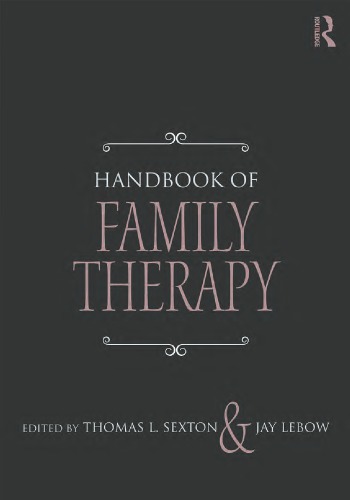t all started with a simple observation. By expanding one’s “lens” from the individual to the entire family, new treatment opportunities and new ways of understanding the seemingly mysterious mechanisms of relationships emerged. By moving the focus of attention from the individual to a relational focus came a new clarity in defining and understanding the “space between” the people in families. In doing so, therapy became a process in which behaviors and interactions were described in terms of a recursive process of mutual influence. For most early family therapists, this also meant “an emphasis on what is happening in the here and now rather than why it is happening or in terms of a historical focus.” Thus, the patterns within relationships became the primary target and goal of most early family therapies. This simple observation and the complex thinking that came quickly after marked the beginning of a paradigm shift akin to a scientific revolution. A paradigm shift, as Kuhn suggests, occurs when anomalies that could not be explained by the prevailing majority view begin to emerge and become significant. Such a scientific revolution occurs when an alternative belief system ushers in a new way to see the world, a different perspective, and new meaning for events otherwise considered not important. The early principles of systems theory and its application to family therapy led to an alternative and comprehensive belief system based on communication, cybernetics, and relational process. Family therapy has evolved a great deal since the publication of the first handbook over- viewing family therapy in 1971. Although the core foundational systemic concepts remain, the practice of family therapy looks much different today than it did fifty years ago. Family therapy has morphed over time from a provocative challenger to the mental health estab- lishment to a widely practiced set of methods that represent best practices in relation to a variety of problems and issues. Further, whereas early family therapy was largely about the argument between proponents of various models regarding who had the “right” theory and best method of practice, today’s family therapy includes emerging consensus about many issues in the field. Family therapy has also moved from an alternative therapy to a set of methods that often coordinate and integrate with other methods of treatment (see, for example, Chapters 12, 16, and 28). Further, some family treatment models have emerged to become among the best illustrations of evidence-based treatment that combine cutting- edge science while embracing the complexity and artfulness of clinical implementation of those models (see Chapters 12–20)
چکیده فارسی
همه چیز با یک مشاهده ساده شروع شد. با گسترش "عدسی" فرد از فرد به کل خانواده، فرصت های درمانی جدید و راه های جدیدی برای درک مکانیسم های به ظاهر مرموز روابط پدیدار شد. با انتقال کانون توجه از فردی به تمرکز رابطه ای، وضوح جدیدی در تعریف و درک "فضای بین" افراد در خانواده ها ایجاد شد. با انجام این کار، درمان به فرآیندی تبدیل شد که در آن رفتارها و تعاملات در قالب فرآیند بازگشتی تأثیر متقابل توصیف میشد. برای اکثر خانوادهدرمانگران اولیه، این به معنای «تاکید بر آنچه در اینجا و اکنون اتفاق میافتد، به جای اینکه چرا اتفاق میافتد یا بر اساس یک تمرکز تاریخی بود» بود. بنابراین، الگوهای درون روابط به هدف و هدف اصلی اکثر درمانهای اولیه خانواده تبدیل شد. این مشاهده ساده و تفکر پیچیده ای که به سرعت پس از آن به وجود آمد، آغاز یک تغییر پارادایم شبیه به یک انقلاب علمی بود. همانطور که کوهن پیشنهاد میکند، یک تغییر پارادایم زمانی رخ میدهد که ناهنجاریهایی که با دیدگاه اکثریت غالب توضیح داده نمیشوند، شروع به ظهور کرده و قابل توجه میشوند. چنین انقلاب علمی زمانی اتفاق میافتد که یک نظام اعتقادی جایگزین راهی جدید برای دیدن جهان، چشماندازی متفاوت و معنای جدیدی برای رویدادهایی که در غیر این صورت مهم تلقی میشوند، ارائه میکند. اصول اولیه نظریه سیستم ها و کاربرد آن در خانواده درمانی منجر به یک سیستم باور جایگزین و جامع مبتنی بر ارتباطات، سایبرنتیک و فرآیند رابطه شد. خانواده درمانی از زمان انتشار اولین کتاب راهنما در مورد خانواده درمانی در سال 1971 بسیار تکامل یافته است. اگرچه مفاهیم اساسی سیستمی و بنیادی همچنان باقی مانده است، عملکرد خانواده درمانی امروزه بسیار متفاوت از پنجاه سال پیش به نظر می رسد. خانواده درمانی در طول زمان از یک چالش برانگیز به تأسیسات بهداشت روانی به مجموعهای از روشهایی که به طور گسترده انجام میشود که بهترین شیوهها را در رابطه با انواع مشکلات و مسائل نشان میدهند، تبدیل شده است. علاوه بر این، در حالی که خانواده درمانی اولیه عمدتاً در مورد بحث بین طرفداران مدل های مختلف در مورد اینکه چه کسی نظریه "درست" و بهترین روش عمل را دارد، بود، خانواده درمانی امروزی شامل اجماع در حال ظهور در مورد بسیاری از مسائل در این زمینه است. خانواده درمانی نیز از یک درمان جایگزین به مجموعه ای از روش هایی که اغلب با سایر روش های درمانی هماهنگ و ادغام می شوند، حرکت کرده است (برای مثال به فصل های 12، 16 و 28 مراجعه کنید). علاوه بر این، برخی از مدلهای درمان خانوادگی به عنوان یکی از بهترین نمونههای درمان مبتنی بر شواهد که علم پیشرفته را ترکیب میکنند و در عین حال پیچیدگی و مهارت اجرای بالینی آن مدلها را در بر میگیرد، ظاهر شدهاند (به فصلهای 12 تا 20 مراجعه کنید)
ادامه ...
بستن ...
Author(s): Thomas L. Sexton (Editor), Jay Lebow (Editor)
Publisher: Routledge, Year: 2016
ISBN: 1138917621,9781138917620,9780415518017
ادامه ...
بستن ...










